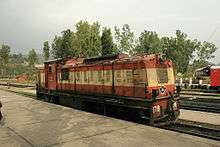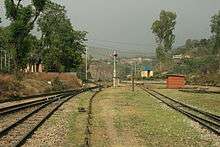Kangra Valley Railway

The Kangra Valley Railway lies in the sub-Himalayan region and covers a distance of 164 km (101.9 mi) from Pathankot, Punjab to Jogindernagar in Himachal Pradesh, India. The Kangra valley railway comes under the Firozpur division of Northern Railway. It is one of two railways that run in Himachal Pradesh, the other being Kalka-Shimla Railway, which has been designated as world heritage site by UNESCO. Indian Railways has identified Pathankot-Jogindernagar route to be converted into 1,676 mm (5 ft 6 in) and to extend it to Mandi, and eventually to Ladakh via a new Bilaspur-Mandi-Leh Railway.[1]
Kangra is a hilly region in Himachal Pradesh which has an average elevation of 733 m (2,405 ft).
History
The railway line was planned in May 1926 and commissioned in 1929. The highest point on this line is at Ahju station at an elevation of 1,290 meters (4,230 ft). The terminus at Joginder Nagar is at an elevation of 1,189 meters (3,901 ft).[2]
About
| Kangra Valley Railway | ||||||||||||||||||||||||||||||||||||||||||||||||||
|---|---|---|---|---|---|---|---|---|---|---|---|---|---|---|---|---|---|---|---|---|---|---|---|---|---|---|---|---|---|---|---|---|---|---|---|---|---|---|---|---|---|---|---|---|---|---|---|---|---|---|
| ||||||||||||||||||||||||||||||||||||||||||||||||||
The Kangra Valley is not one place in particular. It happens to be the name given to the entire region that lies between the Dhauladhar ranges of the Himalayas to the north and the last strangling foothills to the south. So, roughly speaking, this talk is about a narrow rectangular belt running 150 km (93 mi) in length and 50 km (31 mi) in breadth through the mountains. To the north, the peaks rear skyward; first a low chain of ridges followed by an extensive line averaging between 15,000 and 16,000 ft (4,600 and 4,900 m). Directly behind those are massifs rising from 13,000 ft (4,000 m) to well over 16,000 ft (4,900 m). Then the snows.
Anything else would have ruined it. A different alignment, a different mode of taking the railway through the maze of hills and valleys would have spoilt its picture postcard perfectness. This unique line has just two tunnels, one of which is only 250 ft (76 m) and the other 1,000 ft (300 m) in length. The traveler must remember this is a total distance of 103 mi (166 km). Instead of boring his way through the mountains, the railway engineer has skillfully avoided running head first into the hillside. Instead of following dizzy curves, he has cleverly chosen to avoid the awkward corners and straighten his turning. For the Kangra Valley Railway presents to the traveler, a chance to gaze as long as he likes on the ever present panorama of snow-clad ranges and the gold green fields without being swung round every few minutes on a narrow arc before his eyes can greet the scenery.
Certainly the scenery through which the train passes is ample compensation for the extra distance covered as compared to getting there by road. The most picturesque parts of the valley are exposed to the view – the stretch of 18 miles from Mangwal to Kangra, for example, lies through country unsurpassed for its majestic grandeur with the majestic Ban Ganga gorge and the deep Kangra chasm as two piece de resistance. As one approaches Palampur, the ever present background of snowy chain peaks, 15,000 and 16,000 ft (4,600 and 4,900 m) in height is barely ten miles (16 km) away. From here onwards, the line runs parallel to the Dhauladhar range and much nearer to it than any other railways in India that ever comes so close to the eternal snows.
Services
Currently all the services are passenger trains i.e. the trains stop at all stations of II-class and some trains also have FC-class of accommodation. Some specials are run during the holiday season. Chartered trains can also be booked.
Tariffs
At present, reservation of seats is not enabled on this section and therefore the tourists are required to occupy available seats on arrival.
Scheduled Services
Pathankot – Joginder Nagar (N.G.)
| Actual Distance (km) | ↓ Station Name → Train No. | Pass. 1PBJ | Pass. 1PB | Pass. 3PB | Pass. 3PBJ | Pass. 5PB | Pass. 7PB | Pass. 1JP | |
|---|---|---|---|---|---|---|---|---|---|
| .... | Pathankot | 02:40 | 04:30 | 07:00 | 09:50 | 12:55 | 16:15 | 17:00 | |
| 47 | Jawanwala Shahr | 0350 | 0540 | 0840 | 1200 | 1515 | 1745 | 2000 | - - |
| 83 | Jawalamukhi Road | 0553 | 0802 | 1034 | 1334 | 1633 | 2005 | 2120 | |
| 94 | Kangra | 0623 | 0832 | 1108 | 1410 | 1758 | 2047 | - - | |
| 109 | Nagrota | 0702 | 0909 | 1208 | 1526 | 1858 | 2120 | - - | |
| 127 | Palampur | 0755 | 0956 | 1303 | 1634 | 1957 | 2156 | - - | |
| 141 | Baijnath Paprola | 0905 | 1040 | 1350 | 1730 | 2045 | 2245 | - - | |
| 164 | Joginder Nagar | 1115 | - - | - - | 1940 | - - | - - | - - |
Joginder Nagar - Pathankot (N.G.)
| ↓ Station Name → Train No. | Pass. 2JP | Pass. 2PB | Pass. 4PB | Pass. 2PBJ | Pass. 4PBJ | Pass. 6PB | Pass. 8PB |
|---|---|---|---|---|---|---|---|
| Joginder Nagar | - - | - - | - - | 07:20 | 12:20 | - - | - - |
| Baijnath Paprola | - - | 04:15 | 07:20 | 10:45 | 15:55 | 14:10 | 17:35 |
| Palampur(HP) | - - | 04:53 | 08:02 | 11:27 | 16:41 | 14:51 | 18:17 |
| Nagrota | - - | 05:37 | 09:02 | 12:15 | 17:29 | 15:33 | 19:05 |
| Kangra | - - | 06:18 | 09:50 | 12:52 | 18:05 | 16:10 | 19:42 |
| Jawalamukhi Road | 04:45 | 06:57 | 10:28 | 13:25 | 18:33 | 16:40 | 20:12 |
| Jawanwala Shahr | 06:29 | 08:26 | 12:20 | 15:08 | 20:32 | 18:23 | 22:13 |
| Pathankot | 08:40 | 10:45 | 14:30 | 17:10 | 22:45 | 21:10 | 23:40 |
- Timings are subject to revision
Gallery
 Baijnath Paprola station |
 ZDM engine at Baijnath Paprola |
 Towards Jogindernagar |
Train crossing the river at Baijanath |
Ahju Station |
See also
References
External links
| Wikimedia Commons has media related to Kangra Valley Railway. |
- Official Schedule Indian Railway.
- Kangra Valley Railway Northern Railway.
- Kangra Himachal Tourism.
- Kangra Valley Train Timings